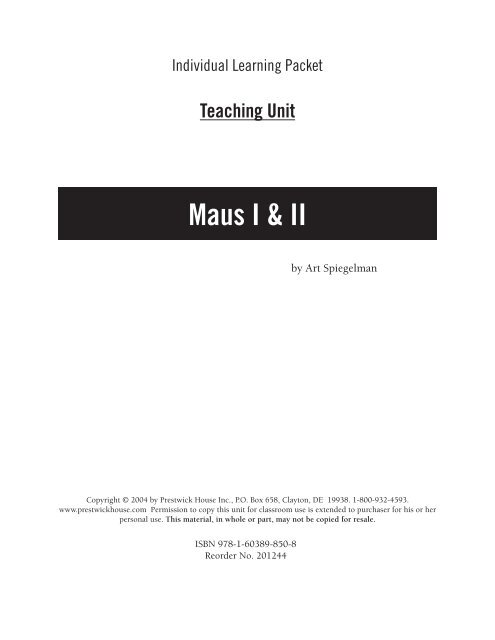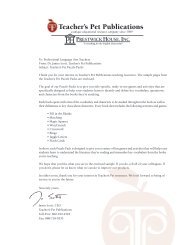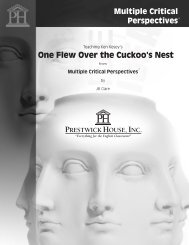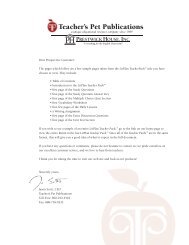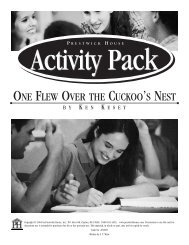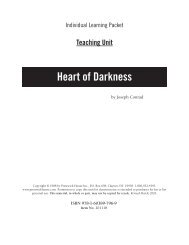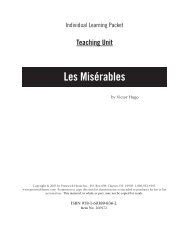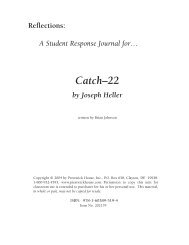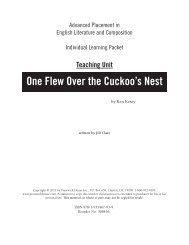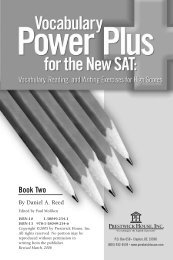Maus I & II - Teaching Unit: Sample Pages - Prestwick House
Maus I & II - Teaching Unit: Sample Pages - Prestwick House
Maus I & II - Teaching Unit: Sample Pages - Prestwick House
You also want an ePaper? Increase the reach of your titles
YUMPU automatically turns print PDFs into web optimized ePapers that Google loves.
Individual Learning Packet<br />
<strong>Teaching</strong> <strong>Unit</strong><br />
<strong>Maus</strong> I & <strong>II</strong><br />
by Art Spiegelman<br />
Copyright © 2004 by <strong>Prestwick</strong> <strong>House</strong> Inc., P.O. Box 658, Clayton, DE 19938. 1-800-932-4593.<br />
www.prestwickhouse.com Permission to copy this unit for classroom use is extended to purchaser for his or her<br />
personal use. This material, in whole or part, may not be copied for resale.<br />
ISBN 978-1-60389-850-8<br />
Reorder No. 201244
<strong>Maus</strong> I & <strong>II</strong> TEACHING UNIT<br />
Notes<br />
Portions of <strong>Maus</strong> I first appeared in Raw, a cutting-edge “comix” journal that Art Spiegelman<br />
founded with his wife, Francoise Mouly. <strong>Maus</strong> I was published in book form in 1986. After<br />
releasing <strong>Maus</strong> <strong>II</strong> in 1991, Spiegelman became the first person to receive a Pulitzer Prize for a<br />
book-length comic. As of early 2004, he remains the only one to have done so.<br />
The appearance of <strong>Maus</strong> I & <strong>II</strong> stood the comic book form on its head, asserting that comics<br />
could be used to great effect to approach the gravest of subjects. Other graphic artists have<br />
since used the medium to explore issues of politics and warfare, most notably Joe Sacco in<br />
Palestine and Safe Area Gorazde: The War in Eastern Bosnia and Marjane Satrapi in Persepolis.<br />
The two-volume <strong>Maus</strong>, however, remains the benchmark by which all other work in the field<br />
is measured.<br />
The writing and art in <strong>Maus</strong> are intricate and bursting with intention intensity, and emotion,<br />
making <strong>Maus</strong> a great entrance into classroom discussions of craft and the choices artists and<br />
writers make.<br />
In studying <strong>Maus</strong>, many readers will be encountering metafiction for the first time. It will be<br />
important—especially when approaching the second volume—to point out the difference<br />
between “Artie,” the character, and Art Spiegelman, the author.<br />
All references come from the 1986 Pantheon paperback edition of <strong>Maus</strong> I: My Father Bleeds<br />
History and the 1991 Pantheon paperback edition of <strong>Maus</strong> <strong>II</strong>: And Here My Troubles Began.<br />
2<br />
NOTES
<strong>Maus</strong> I & <strong>II</strong> TEACHING UNIT<br />
Objectives<br />
By the end of this <strong>Unit</strong>, the student will be able to:<br />
1. define the vocabulary words listed in the study guide.<br />
2. define and point out examples in <strong>Maus</strong> I and/or <strong>Maus</strong> <strong>II</strong> of<br />
• frame narrative<br />
• symbolism<br />
• metaphor<br />
• metafiction<br />
• comic relief<br />
• irony<br />
• foreshadowing<br />
• catachresis<br />
• parallelism<br />
• mixed metaphor<br />
• dialect<br />
• pun<br />
• epigraph<br />
• litotes<br />
• paradox<br />
• juxtaposition<br />
3. identify Vladek’s chief motivations and describe the ways in which they help him to survive.<br />
4. evaluate the effectiveness and aptness of Spiegelman’s “cat and mouse” metaphor in <strong>Maus</strong>.<br />
5. point out instances in the text of the use of artistic deviations to emphasize or parallel<br />
the emotional content of the story.<br />
6. demonstrate a basic knowledge of the progression of Nazi actions against Polish<br />
Jews during World War <strong>II</strong>, beginning with the setting of curfews and ending at the<br />
concentration camps.<br />
7. assess Spiegelman’s decision to weave the stories of the young and the elderly Vladek<br />
together rather than telling them separately.<br />
8. understand the limitations of comics or any other form of writing or art to represent<br />
historical reality without distortion.<br />
9. understand the concept of “craft” and intentional choice in composition and notice<br />
these when approaching a creative work.<br />
5<br />
OBJECTIVES
<strong>Maus</strong> I & <strong>II</strong> TEACHING UNIT<br />
Questions for Essay and Discussion<br />
1. Discuss the effectiveness of the frequent movement from the story of the young Vladek<br />
and the Holocaust to the story of the elderly Vladek and his relationship with Artie (and<br />
back). Would the story of the young Vladek have more emotional weight if Spiegelman<br />
had decided to tell it in one uninterrupted piece? Defend your answer.<br />
2. Discuss the usefulness of the “cat and mouse” metaphor in <strong>Maus</strong>, considering the following:<br />
A. How apt is the metaphor? Does it extend beyond the one-dimensional suggestion of<br />
a cat-and-mouse chase or of cats toying with their prey?<br />
B. Cats hunt mice for a practical reason–their own survival. What did the Nazis believe<br />
was the practical reason for hunting Jews? Why did Nazis deem it necessary to their<br />
own survival?<br />
C. Some have suggested that Spiegelman’s point is that humans are “nothing but<br />
animals.” Do you agree with this interpretation? Why or why not?<br />
D. What characteristics or circumstances do Spiegelman’s Jews share with mice? What<br />
were the “mouse holes” of Nazi Germany?<br />
3. As a librarian faced with the challenge of finding an appropriate location for <strong>Maus</strong>,<br />
would you shelve it with histories, comic books, biographies, fiction, or in some other<br />
pre-existing section? Defend your choice with specific examples from the book.<br />
4. Using specific examples from the text, compare the artistic and narrative styles of the<br />
bulk of <strong>Maus</strong> with those of Prisoner on the Hell Planet, in <strong>Maus</strong> I. How does the form of<br />
each reflect its content?<br />
5. An old saying has it that, while some wait for good luck, others make their own good<br />
luck. Using specific examples from the text, explain how this saying applies to Vladek.<br />
6. Vladek tells his story in broken English peppered with Yiddish, Hebrew, and German<br />
words. What impact does the language in which his story is delivered have on the<br />
story itself? What, if anything, would be lost if Vladek’s language were rendered into<br />
standard—or proper—English?<br />
7. In <strong>Maus</strong> <strong>II</strong>, Artie worries that “reality is too complex for comics…so much has to be left<br />
out or distorted.” What other approaches to recording “reality” or history in writing or<br />
pictures result in a lot being “left out” or “distorted”?<br />
8. Explain the place and value of comedy in <strong>Maus</strong> I and <strong>Maus</strong> <strong>II</strong>. Is it appropriate in a work<br />
that deals with the Holocaust? Why do you think comedy and irony are included in the<br />
bulk of <strong>Maus</strong>, but are utterly absent from Prisoner on the Hell Planet?<br />
9. Evaluate Spiegelman’s decision to include the story of Lucia in <strong>Maus</strong> I. Why does<br />
Spiegelman feel it necessary to make the story of Jews in the Holocaust “more REAL,<br />
more human”? (<strong>Maus</strong> I)<br />
7<br />
QUESTIONS FOR ESSAY AND DISCUSSION
<strong>Maus</strong> I & <strong>II</strong> STUDENT COPY<br />
Chapter One: The Sheik<br />
VOCabUlarY<br />
dowry – the money or possessions that a woman brings to her husband at marriage<br />
textiles – fabric<br />
1. What is the first thing we learn about Artie’s mother?<br />
2. Why does Artie’s father object when Mala gives Artie a wire hanger on which to hang<br />
his coat?<br />
3. What sort of drawings does Vladek think Artie should spend his time making?<br />
4. We finally get our first shot of Artie’s father as a young man. What do you make of the<br />
shape Spiegelman uses for this panel?<br />
2<br />
STUDY GUIDE
<strong>Maus</strong> I & <strong>II</strong> STUDENT COPY<br />
Chapter Five: Mouse Holes<br />
VOCabUlarY<br />
“Juden Raus!” – German for “Jews, out!”<br />
liquidate – to put an end to; to abolish (also: to kill)<br />
meshuga – Yiddish slang for “crazy; senseless”<br />
neurotic – overanxious; panicky<br />
nu – Yiddish for “so” or “obviously”<br />
oi [oy] – Yiddish for “oh!” or “My God!”<br />
1. Why is Artie reluctant to use tools or fix things around the house?<br />
2. From what you have learned of Vladek and Artie so far, do you think Artie correctly or<br />
mistakenly read Vladek’s motives during their work around the house in Artie’s youth?<br />
Is Vladek a show-off? Would he enjoy proving Artie wrong?<br />
3. Artie says to Francoise, “One reason I became an artist was that [Vladek] thought it<br />
was impractical—just a waste of time…it was an area where I wouldn’t have to compete<br />
with him.” What does this reveal about Artie’s feelings towards his father, and perhaps<br />
towards his father’s ordeal?<br />
4. What costume does Art portray himself in in Prisoner on the Hell Planet?<br />
14<br />
STUDY GUIDE
<strong>Maus</strong> I & <strong>II</strong> STUDENT COPY<br />
Chapter Two: Auschwitz (Time Flies)<br />
VOCabUlarY<br />
absolution – the act of having one’s sins cleansed away<br />
appel – German for “an assembly”<br />
cathartic – emotionally purging<br />
hermetic – air-tight<br />
munitions – weapons and ammunition<br />
notary – one legally empowered to certify documents<br />
1. Spiegelman writes, “Vladek started working as a tinman in Auschwitz in the spring of<br />
1944…I started working on this page at the very end of February 1987.” He uses this<br />
same kind of balanced sentence structure to report the dates of other “then” and “now”<br />
events. What is the technical term for this kind of structure?<br />
2. On the first page of this chapter, Spiegelman portrays himself—not “Artie”—for the first<br />
time. He draws himself as a human in a mouse mask. How does this differ markedly<br />
from the way he drew Vladek wearing a pig mask in <strong>Maus</strong> I? What is the significance of<br />
the difference?<br />
3. Why are flies buzzing around Spiegelman as he sits at his drawing board? What do the<br />
corpses signify?<br />
4. A man offers Spiegelman an advertising deal, casually referring to Spiegelman as “Artie”<br />
and saying, “We’ll make a million! Your dad would be proud!” What do both the man’s<br />
use of the familiar “Artie” and his assumption about Vladek indicate about the way<br />
Spiegelman feels about the reception of <strong>Maus</strong> I?<br />
27<br />
STUDY GUIDE


